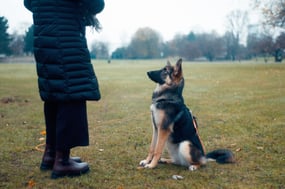Why A Well-Trained Pet Finds It Easier To Travel
Updated on: December 14, 2022 | Author: Starwood Pet Travel
 A well-trained pet can learn to accept travel as “just another day” rather than a Scary Big Deal, and that can make everyone’s travel experience far less stressful.
A well-trained pet can learn to accept travel as “just another day” rather than a Scary Big Deal, and that can make everyone’s travel experience far less stressful.
Training is the process of becoming familiar with something and adapting behavior accordingly. Your dog gets this. They like learning because they have a sense of adventure and are eager to please. Your cat, on the other hand, probably doesn’t subscribe to the “training” concept. They're plenty curious, but only on their own terms. Nonetheless the more you can do to make travel seem normal to them, the more relaxed they will be.
Pets look to you for direction and assurance, so their trust in you can help when it’s time to travel. The more time you spend with your cat or dog leading up to their travels, the more you’re reassuring them that you’re in it together and it’s all good.
Obedience classes
Training your dog to consistently sit, stay and come on command boosts safety in the event they ever get loose, especially in an unfamiliar, confusing environment. It builds their confidence and peace of mind. Training time, whether in formal classes or informally on your own, is also a form of playful interaction that strengthens your mutual bond.
Airlines won’t accept openly aggressive dogs, but sometimes pets can act aggressively out of fear. Because training builds confidence, it helps alleviate fear.
Travel kennel acclimation
The single most important training you can give your pet is to acclimate them to their kennel. That way, they see that their kennel is “theirs” and that it’s a safe place to be no matter what. Cats and dogs must travel in an airline-approved kennel, so the key is to purchase it weeks or even months in advance.
If your pet has never spent time in a crate, they may see it as a “trap.” Start them off slowly by letting them get used to the bottom half of the kennel, without the top. If your dog is too wary to even step foot in it at first, sit in the open bottom section yourself and have them sit near you on the outside. Or just sit next to it with them. Pet them and speak positively, so they focus on you instead of the kennel and associate being near it as a good experience.
Have your dog stand or sit in the bottom half of the kennel - a position that enables them to easily maintain their view of the entire room so they won't feel enclosed. Use plenty of treats and positive reinforcement. Eventually, have them lie down. You can actually teach your dog (or cat) to enter the kennel and curl around to lie down by using a leash and a treat concealed in your hand just in front of their nose to lead them. It’s easier to do this with the top off.
Your cat is naturally curious, so they may explore the carrier on their own, but you can encourage them by placing food or one of their favorite toys inside. If they associate the kennel with a trip to the vet, show them travel isn’t always a hideous experience by taking them for some car rides that result in a treat rather than poking and prodding.
For both cats and dogs, providing treats, toys, and bedding inside the kennel helps them see it as a positive, pleasant environment.
Even if you plan to carry your kitty or purse-sized pooch on board with you, they’ll have to remain in their carrier under the seat in front of you. You’ll be right there to reassure them, if necessary, but they will be mostly calm if they’re comfortably familiar with that carrier.
Potty training
Even the most reliable pet can have an accident when they’re under duress, which is why you should place some absorbent bedding in the carrier. It will be more comfortable, too. You can use paper, but not a newspaper. You can also use potty training pads.
Understanding your pet’s “digestive timing” will help you plan ahead. Experts suggest reducing food intake on the day of travel, but water is always a necessity. Just before loading your dog into the travel kennel, walk them so they can relieve themselves and start off with an empty bladder. This is a little more tricky for cats since they can't have a litter box and litter inside the kennel on a plane. You can still use a training pad for them in case they really gotta go.
Noise
Many animals are sound-sensitive, some intensely so. You can’t very well replicate an airport or airplane, but you can train dogs to get used to noisy, chaotic environments.
Take them to lots of places where they can encounter new situations safely, with you at their side. Sit in the bleachers at a local ball game where there’s plenty of noise and strange people and smells. Use treats and praise to reward them for successfully meeting these new challenges. You can also consider enrolling your dog in pet-therapy classes where they will learn to calmly cope with all sorts of unusual situations.
Motion sickness
This is much less likely to occur on a plane than in a car, where pets are often made queasy by the sight of objects moving rapidly past the window. There are things you can do to help your pet gradually get used to the movement, but if they have a significant problem with this you should speak with your vet.
Teach by example
As you’re going about your business making arrangements for moving and travel, bear in mind that disruption and change can trigger anxiety in pets. If you’re frazzled and jumpy, they will be, too. If you’re calm and confident, your demeanor will train them that things may be different, but all is well.
Subscribe to the Blog
Enjoy our content? Get them sent to your inbox!
Subscribe Now!

